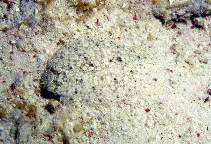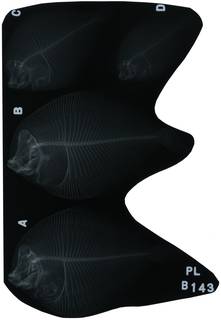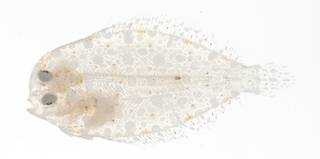
| Introduction | | Search taxa | | Taxon tree | | Taxon match | | Checklist | | Literature | | Stats | | Photogallery | | OBIS Vocab | | Log in |
CaRMS taxon detailsBothus ocellatus (Agassiz, 1831)
159275 (urn:lsid:marinespecies.org:taxname:159275)
accepted
Species
marine,
(of ) Spix, J. B.; von; Agassiz, L. (1829-1831). Selecta genera et species piscium quos in itinere per Brasiliam annis MDCCCXVII-MDCCCXX : jussu et auspiciis Maximiliani Josephi I. Bavariae regis augustissimi peracto. <em>Monachii.</em> Part 1: i-xvi + i-ii + 1-6 + 1-82, Pls. 1-48, Part 2: 83-138, Pls. 49-101. [Part 1 published June 1829, part 2 Jan. 1831., available online at https://www.biodiversitylibrary.org/page/57839229#page/1/mode/1up [details]
Distribution Western Atlantic: Bay of Fundy, New York, Bermuda, and northern Gulf of Mexico to southern Brazil
Distribution Western Atlantic: Bay of Fundy, New York, Bermuda, and northern Gulf of Mexico to southern Brazil [details]
Froese, R. and D. Pauly. Editors. (2021). FishBase. Bothus ocellatus (Agassiz, 1831). Accessed through: Nozères, C., Kennedy, M.K. (Eds.) (2021) Canadian Register of Marine Species at: http://marinespecies.org/carms./aphia.php?p=taxdetails&id=159275 on 2024-04-16
Nozères, C., Kennedy, M.K. (Eds.) (2024). Canadian Register of Marine Species. Bothus ocellatus (Agassiz, 1831). Accessed at: https://marinespecies.org/carms/aphia.php?p=taxdetails&id=159275 on 2024-04-16
original description
(of ) Spix, J. B.; von; Agassiz, L. (1829-1831). Selecta genera et species piscium quos in itinere per Brasiliam annis MDCCCXVII-MDCCCXX : jussu et auspiciis Maximiliani Josephi I. Bavariae regis augustissimi peracto. <em>Monachii.</em> Part 1: i-xvi + i-ii + 1-6 + 1-82, Pls. 1-48, Part 2: 83-138, Pls. 49-101. [Part 1 published June 1829, part 2 Jan. 1831., available online at https://www.biodiversitylibrary.org/page/57839229#page/1/mode/1up [details]
context source (Deepsea) Intergovernmental Oceanographic Commission (IOC) of UNESCO. The Ocean Biogeographic Information System (OBIS), available online at http://www.iobis.org/ [details] context source (Bermuda) Smith-Vaniz, W. F.; Collette, B. B.; Luckhurst, B. E (1999). Fishes of Bermuda: History, zoogeography, annotated checklist, and identification keys (American Society of Ichthyologists and Herpetologists - Special Publication No.4) . ASIH, 424 pp. [details] basis of record Scott, W.B.; Scott, M.G. (1988). Atlantic fishes of Canada. <em>Canadian Bulletin of Fisheries and Aquatic Sciences.</em> No. 219. 731 pp. [details] additional source McEachran, J. D. (2009). Fishes (Vertebrata: Pisces) of the Gulf of Mexico, Pp. 1223–1316 in: Felder, D.L. and D.K. Camp (eds.), Gulf of Mexico–Origins, Waters, and Biota. Biodiversity. Texas A&M Press, College Station, Texas. [details] additional source Froese, R. & D. Pauly (Editors). (2023). FishBase. World Wide Web electronic publication. version (02/2023)., available online at https://www.fishbase.org [details] additional source Gulf of Maine Biogeographic Information System (GMBIS) Electronic Atlas. 2002. November, 2002. [details] ecology source Looby, A.; Erbe, C.; Bravo, S.; Cox, K.; Davies, H. L.; Di Iorio, L.; Jézéquel, Y.; Juanes, F.; Martin, C. W.; Mooney, T. A.; Radford, C.; Reynolds, L. K.; Rice, A. N.; Riera, A.; Rountree, R.; Spriel, B.; Stanley, J.; Vela, S.; Parsons, M. J. G. (2023). Global inventory of species categorized by known underwater sonifery. <em>Scientific Data.</em> 10(1). (look up in IMIS), available online at https://doi.org/10.1038/s41597-023-02745-4 [details]  Present Present  Inaccurate Inaccurate  Introduced: alien Introduced: alien  Containing type locality Containing type locality
From other sources
Diet About one-third of the diet consists of fishes; the rest of its food is crustaceans: crabs, shrimps, amphipods, and mantis shrimps [details]Distribution Western Atlantic: Bay of Fundy, New York, Bermuda, and northern Gulf of Mexico to southern Brazil [details] Habitat Inhabits sandy areas with coral rubble or seagrasses, usually near patch reefs. [details] Habitat benthic [details] Importance Social- Minor commerical fishery [details]
To Barcode of Life (98 barcodes)
To Biodiversity Heritage Library (19 publications) To European Nucleotide Archive (ENA) To FishBase To FishBase images (Bothus ocellatus, Neth Antilles, by Patzner, R.) To GenBank (58 nucleotides; 52 proteins) To Global Biotic Interactions (GloBI) To IUCN Red List (Least Concern) To NMNH Extant Collection (Bothus ocellatus RAD103746-001) To NMNH Extant Collection (Bothus ocellatus USNM 414100 eyed side view) To ITIS |


